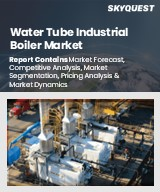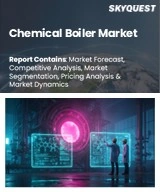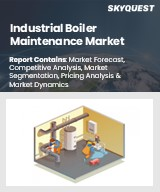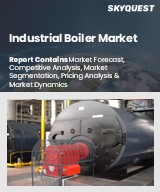
|
시장보고서
상품코드
1741014
가스 연소 저온 상업용 보일러 시장 : 시장 기회, 성장 촉진요인, 산업 동향 분석 및 예측(2025-2034년)Gas Fired Low Temperature Commercial Boiler Market Opportunity, Growth Drivers, Industry Trend Analysis, and Forecast 2025 - 2034 |
||||||
세계의 가스 연소 저온 상업용 보일러 시장은 2024년에는 33억 달러로 평가되었고, 고효율 난방 시스템에 대한 수요 증가와 에너지 소비량 삭감 및 환경에 대한 영향의 최소화를 요구하는 정부압력 증가에 의해 CAGR 6.4%로 성장할 전망이며, 2034년에는 62억 달러에 이를 것으로 예측됩니다.
이 시장은 기업이 지속 가능한 사업 운영을 향해 점점 시프트하고 있기 때문에 강한 기세를 보이고 있습니다. 기후변화에 대한 우려가 커지는 가운데 상업 부문은 국제적인 이산화탄소 감축 목표에 따른 보다 깨끗한 기술의 채택을 강력히 요구하고 있습니다.

급속한 도시화, 상업용 부동산의 확대, 에너지 효율이 높은 개수 프로젝트에 대한 요구의 고조도, 채용율에 박차를 가하고 있습니다. 기업은 더 이상, 효율적인 난방 시스템을 호화품으로서는 아니고, 경쟁력을 유지해, 경쟁에 대응하기 위한 필수품이라고 생각하게 되어 있습니다. 건축기준법의 변화, 에너지 효율 업그레이드를 위한 공적 자금 지원, 생애주기 비용 절감에 대한 관심의 고조는 시장 궤도를 더욱 가속화시키고 있습니다. 게다가 난방 시스템에 IoT와 AI 등 디지털 기술의 통합이 진행되면서 기존 보일러가 에너지 소비와 운용 효율의 최적화를 지원하는 스마트하고 응답성이 높은 자산으로 변화하고 있습니다.
| 시장 범위 | |
|---|---|
| 시작 연도 | 2024년 |
| 예측 연도 | 2025-2034년 |
| 시작 금액 | 33억 달러 |
| 예측 금액 | 62억 달러 |
| CAGR | 6.4% |
배출 규제의 엄격화와 지속 가능한 에너지 솔루션의 긴급 요구가 상업 부문을 보다 깨끗하고 효율적인 난방 기술로 밀어 올리고 있습니다. 보일러 시스템의 기술적 진보는 세계 상업 인프라의 확대와 맞물려 유망한 시장 전망을 형성하고 있습니다. 탄소 배출 억제에 대한 대처가 강화되는 가운데, 기업은 컴플리언스 및 비용 효율의 양쪽 모두를 제공하는 저배출 기술로 급속히 이행하고 있습니다. 천연가스를 연료로 하는 이러한 보일러는 저온에서 운전되기 때문에 성능을 손상시키지 않고 에너지 사용량을 삭감하고 싶은 상업 환경에 매우 적합합니다.
상업건설 및 고등교육에 대한 투자가 더욱 성장을 가속하고, 학교, 복합오피스빌딩, 복합용도빌딩에서 효율적인 난방 수요를 밀어 올리고 있습니다. 세계 무역 정책은, 수입 부품의 관세에 의해서 제조 비용에 영향을 줄지도 모르지만, 동시에 국내 제조의 확대를 재촉해, 보다 강고하고 탄력성이 있는 공급망을 육성하고 있습니다.
콘덴싱 가스 연소 저온 상업용 보일러 분야는 2034년까지 CAGR 9.5%의 강력한 성장이 예측됩니다. 이러한 고급 시스템은 클라우드 통합, 예지 보전, 스마트 에너지 최적화를 특징으로 하며 점점 연결되고 있습니다. 이러한 기능은, 운용 비용을 억제하면서 성능을 큰폭으로 향상시킵니다. 상업 공간의 에너지 개수를 지원하는 공적 자금이 스마트 보일러 기술의 채택을 더욱 뒷받침하고 있습니다.
120°F 미만의 가스 연소 저온 보일러 시장은 2034년까지 14억 달러를 창출할 것으로 예측되고 있습니다. 이러한 보일러는 현대의 지속 가능성 벤치마크 및 규제 효율 기준을 충족하여 기존 시스템보다 우수한 열성능을 제공합니다. 운용 비용을 삭감해, 진화하는 환경 규제에 대응하는 것을 목표로 하는 기업에 있어서, 급속히 바람직한 선택사항이 되고 있습니다.
미국의 가스 연소 저온 상업용 보일러 시장은 2024년에 8억 1,210만 달러에 달했습니다. 상업 건설 활동의 성장은 신뢰성 있고 효율적인 난방 솔루션의 필요성을 계속 부추기고 있습니다. 설치가 용이하고 유지보수의 필요성이 낮으며 안전기능이 강화된 보일러는 대규모 상업 용도에 이상적인 선택지입니다.
시장 포지션을 강화하기 위해 Precision Boilers, Fondital, Bosch Industriekessel, Ariston Holding, Viessmann, Hurst Boiler & Welding, Immergas, Lochinvar, Burnham Commercial Boilers, Ferroli, Fulton, Cleaver-Brooks, Vaillant Group International, Bradford White Corporation, Weil-McLain, Hoval, Babcock & Wilcox 및 Wolf 등의 기업이 제품을 확대하고 있습니다. Wilcox 및 Wolf는 에너지 효율적인 모델로 제품 라인을 확대하고 스마트 보일러 기술에 많은 투자를 하며 건설사 및 에너지 서비스 회사와 파트너십을 맺고 있습니다. 이들 기업은 또, 저탄소 시스템의 연구 개발 노력을 가속해, 세계의 기후 변화 목표에 따르도록, 주요 지역에서의 제조 능력을 확대하고 있습니다.
목차
제1장 조사 방법 및 범위
제2장 주요 요약
제3장 업계 인사이트
- 생태계 분석
- 트럼프 정권의 관세 분석
- 무역에 미치는 영향
- 무역량의 혼란
- 보복 조치
- 업계에 미치는 영향
- 공급측의 영향(원재료)
- 주요 원재료의 가격 변동
- 공급망 재구성
- 생산 비용에 미치는 영향
- 수요측의 영향(판매가격)
- 최종 시장에 대한 가격 전달
- 시장 점유율 동향
- 소비자의 반응 패턴
- 공급측의 영향(원재료)
- 영향을 받는 주요 기업
- 전략적인 업계 대응
- 공급망 재구성
- 가격 설정 및 제품 전략
- 정책관여
- 전망 및 향후 검토 사항
- 무역에 미치는 영향
- 규제 상황
- 업계에 미치는 영향요인
- 성장 촉진요인
- 업계의 잠재적 위험 및 과제
- 성장 가능성 분석
- Porter's Five Forces 분석
- PESTEL 분석
제4장 경쟁 구도
- 서문
- 전략적 전망
- 혁신 및 지속가능성의 정세
제5장 시장 규모 및 예측 : 온도별(2021-2034년)
- 주요 동향
- 120도 이하
- 120-140도
- 140-160도
- 160°F 이상-180°F 이하
제6장 시장 규모 및 예측 : 용량별(2021-2034년)
- 주요 동향
- 0.3-2.5 MMBTU/시 이하
- 2.5-10 MMBTU/시 이상
- 10-50 MMBTU/시 이상
- 50-100 MMBTU/시 이상
- 100-250 MMBTU/시 이상
제7장 시장 규모 및 예측 : 기술별(2021-2034년)
- 주요 동향
- 응축
- 불응축
제8장 시장 규모 및 예측 : 용도별(2021-2034년)
- 주요 동향
- 사무실
- 의료시설
- 교육기관
- 숙박 시설
- 소매점
- 기타
제9장 시장 규모 및 예측 : 지역별(2021-2034년)
- 주요 동향
- 북미
- 미국
- 캐나다
- 멕시코
- 유럽
- 프랑스
- 영국
- 폴란드
- 이탈리아
- 스페인
- 오스트리아
- 독일
- 스웨덴
- 러시아
- 아시아태평양
- 중국
- 인도
- 필리핀
- 일본
- 한국
- 호주
- 인도네시아
- 중동 및 아프리카
- 사우디아라비아
- 이란
- 아랍에미리트(UAE)
- 나이지리아
- 남아프리카
- 라틴아메리카
- 아르헨티나
- 칠레
- 브라질
제10장 기업 프로파일
- Ariston Holding
- Babcock & Wilcox
- Bosch Industriekessel
- Bradford White Corporation
- Burnham Commercial Boilers
- Cleaver-Brooks
- Ferroli
- Fondital
- Fulton
- Hoval
- Hurst Boiler & Welding
- Immergas
- Lochinvar
- Precision Boilers
- Vaillant Group International
- Viessmann
- Weil-McLain
- Wolf
The Global Gas Fired Low Temperature Commercial Boiler Market was valued at USD 3.3 billion in 2024 and is estimated to grow at a CAGR of 6.4% to reach USD 6.2 billion by 2034, driven by the rising demand for high-efficiency heating systems and growing government pressure to reduce energy consumption and minimize environmental impact. The market is witnessing strong momentum as businesses increasingly shift toward sustainable operations. With climate change concerns intensifying, commercial sectors are under mounting pressure to adopt cleaner technologies that align with international carbon reduction goals.
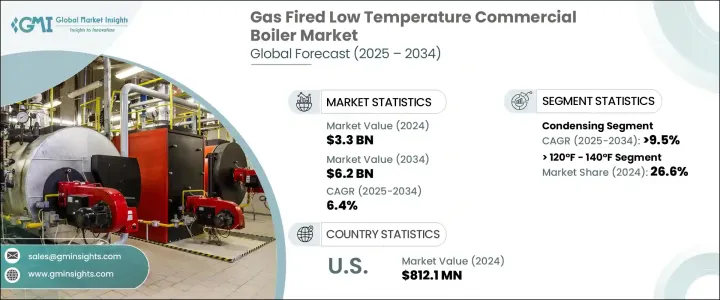
Rapid urbanization, expanding commercial real estate, and the growing need for energy-efficient retrofitting projects are also fueling adoption rates. Businesses are no longer viewing efficient heating systems as a luxury but as a necessity to stay competitive and compliant. Shifts in building codes, public funding for energy efficiency upgrades, and a sharper focus on lifecycle cost savings are further accelerating the market trajectory. Additionally, the rising integration of digital technologies such as IoT and AI into heating systems is transforming traditional boilers into smart, responsive assets that help optimize energy consumption and operational efficiency.
| Market Scope | |
|---|---|
| Start Year | 2024 |
| Forecast Year | 2025-2034 |
| Start Value | $3.3 Billion |
| Forecast Value | $6.2 Billion |
| CAGR | 6.4% |
Stricter emission regulations and the urgent need for sustainable energy solutions are pushing commercial sectors toward cleaner and more efficient heating technologies. Technological advancements in boiler systems, coupled with expanding commercial infrastructure worldwide, are shaping a promising market outlook. As efforts to control carbon emissions intensify, companies are moving rapidly toward low-emission technologies that offer both compliance and cost-efficiency. These boilers, fueled by natural gas, operate at lower temperatures, making them a perfect fit for commercial environments looking to cut energy use without compromising performance.
Investment in commercial construction and tertiary education is driving further growth, boosting the demand for efficient heating in schools, office complexes, and mixed-use buildings. While global trade policies may impact production costs due to tariffs on imported components, they are simultaneously encouraging domestic manufacturing expansion and fostering stronger, more resilient supply chains.
The condensing gas fired low temperature commercial boiler segment is projected to grow at a robust CAGR of 9.5% through 2034. These advanced systems are becoming increasingly connected, featuring cloud integration, predictive maintenance, and smart energy optimization. Such features significantly enhance performance while keeping operational costs in check. Supportive public funding for energy retrofitting in commercial spaces is giving an additional push to the adoption of smart boiler technologies.
The <= 120°F gas fired low temperature boiler market is forecasted to generate USD 1.4 billion by 2034. These boilers meet modern sustainability benchmarks and regulatory efficiency standards, offering better thermal performance than traditional systems. They are quickly becoming the preferred choice for businesses aiming to lower operational costs and meet evolving environmental mandates.
The U.S. Gas Fired Low Temperature Commercial Boiler Market reached USD 812.1 million in 2024. Growth in commercial construction activities continues to fuel the need for reliable, efficient heating solutions. Easy installation, low maintenance requirements, and enhanced safety features make these boilers an ideal option for large-scale commercial applications.
To strengthen their market position, companies such as Precision Boilers, Fondital, Bosch Industriekessel, Ariston Holding, Viessmann, Hurst Boiler & Welding, Immergas, Lochinvar, Burnham Commercial Boilers, Ferroli, Fulton, Cleaver-Brooks, Vaillant Group International, Bradford White Corporation, Weil-McLain, Hoval, Babcock & Wilcox, and Wolf are expanding their product lines with energy-efficient models, investing heavily in smart boiler technologies, and forming partnerships with construction firms and energy service companies. These firms are also accelerating R&D efforts for low-carbon systems and expanding manufacturing capabilities in key regions to align with global climate objectives.
Table of Contents
Chapter 1 Methodology & Scope
- 1.1 Research design
- 1.2 Market estimates & forecast parameters
- 1.3 Forecast calculation
- 1.4 Data sources
- 1.4.1 Primary
- 1.4.2 Secondary
- 1.4.2.1 Paid
- 1.4.2.2 Public
- 1.5 Market definitions
Chapter 2 Executive Summary
- 2.1 Industry synopsis, 2021 - 2034
Chapter 3 Industry Insights
- 3.1 Industry ecosystem analysis
- 3.2 Trump administration tariffs analysis
- 3.2.1 Impact on trade
- 3.2.1.1 Trade volume disruptions
- 3.2.1.2 Retaliatory measures
- 3.2.2 Impact on the industry
- 3.2.2.1 Supply-side impact (raw material)
- 3.2.2.1.1 Price volatility in key materials
- 3.2.2.1.2 Supply chain restructuring
- 3.2.2.1.3 Production cost implications
- 3.2.2.2 Demand-side impact (selling price)
- 3.2.2.2.1 Price transmission to end markets
- 3.2.2.2.2 Market share dynamics
- 3.2.2.2.3 Consumer response patterns
- 3.2.2.1 Supply-side impact (raw material)
- 3.2.3 Key companies impacted
- 3.2.4 Strategic industry responses
- 3.2.4.1 Supply chain reconfiguration
- 3.2.4.2 Pricing and product strategies
- 3.2.4.3 Policy engagement
- 3.2.5 Outlook and future considerations
- 3.2.1 Impact on trade
- 3.3 Regulatory landscape
- 3.4 Industry impact forces
- 3.4.1 Growth drivers
- 3.4.2 Industry pitfalls & challenges
- 3.5 Growth potential analysis
- 3.6 Porter's analysis
- 3.6.1 Bargaining power of suppliers
- 3.6.2 Bargaining power of buyers
- 3.6.3 Threat of new entrants
- 3.6.4 Threat of substitutes
- 3.7 PESTEL analysis
Chapter 4 Competitive Landscape, 2025
- 4.1 Introduction
- 4.2 Strategic outlook
- 4.3 Innovation & sustainability landscape
Chapter 5 Market Size and Forecast, By Temperature, 2021 – 2034 (Units, MMBTU/hr & USD Million)
- 5.1 Key trends
- 5.2 ≤ 120°F
- 5.3 > 120°F - 140°F
- 5.4 > 140°F - 160°F
- 5.5 > 160°F - 180°F
Chapter 6 Market Size and Forecast, By Capacity, 2021 – 2034 (Units, MMBTU/hr & USD Million)
- 6.1 Key trends
- 6.2 ≤ 0.3 - 2.5 MMBTU/hr
- 6.3 > 2.5 - 10 MMBTU/hr
- 6.4 > 10 - 50 MMBTU/hr
- 6.5 > 50 - 100 MMBTU/hr
- 6.6 > 100 - 250 MMBTU/hr
Chapter 7 Market Size and Forecast, By Technology, 2021 – 2034 (Units, MMBTU/hr & USD Million)
- 7.1 Key trends
- 7.2 Condensing
- 7.3 Non-condensing
Chapter 8 Market Size and Forecast, By Application, 2021 – 2034 (Units, MMBTU/hr & USD Million)
- 8.1 Key trends
- 8.2 Offices
- 8.3 Healthcare facilities
- 8.4 Educational institutions
- 8.5 Lodgings
- 8.6 Retail stores
- 8.7 Others
Chapter 9 Market Size and Forecast, By Region, 2021 – 2034 (Units, MMBTU/hr & USD Million)
- 9.1 Key trends
- 9.2 North America
- 9.2.1 U.S.
- 9.2.2 Canada
- 9.2.3 Mexico
- 9.3 Europe
- 9.3.1 France
- 9.3.2 UK
- 9.3.3 Poland
- 9.3.4 Italy
- 9.3.5 Spain
- 9.3.6 Austria
- 9.3.7 Germany
- 9.3.8 Sweden
- 9.3.9 Russia
- 9.4 Asia Pacific
- 9.4.1 China
- 9.4.2 India
- 9.4.3 Philippines
- 9.4.4 Japan
- 9.4.5 South Korea
- 9.4.6 Australia
- 9.4.7 Indonesia
- 9.5 Middle East & Africa
- 9.5.1 Saudi Arabia
- 9.5.2 Iran
- 9.5.3 UAE
- 9.5.4 Nigeria
- 9.5.5 South Africa
- 9.6 Latin America
- 9.6.1 Argentina
- 9.6.2 Chile
- 9.6.3 Brazil
Chapter 10 Company Profiles
- 10.1 Ariston Holding
- 10.2 Babcock & Wilcox
- 10.3 Bosch Industriekessel
- 10.4 Bradford White Corporation
- 10.5 Burnham Commercial Boilers
- 10.6 Cleaver-Brooks
- 10.7 Ferroli
- 10.8 Fondital
- 10.9 Fulton
- 10.10 Hoval
- 10.11 Hurst Boiler & Welding
- 10.12 Immergas
- 10.13 Lochinvar
- 10.14 Precision Boilers
- 10.15 Vaillant Group International
- 10.16 Viessmann
- 10.17 Weil-McLain
- 10.18 Wolf






